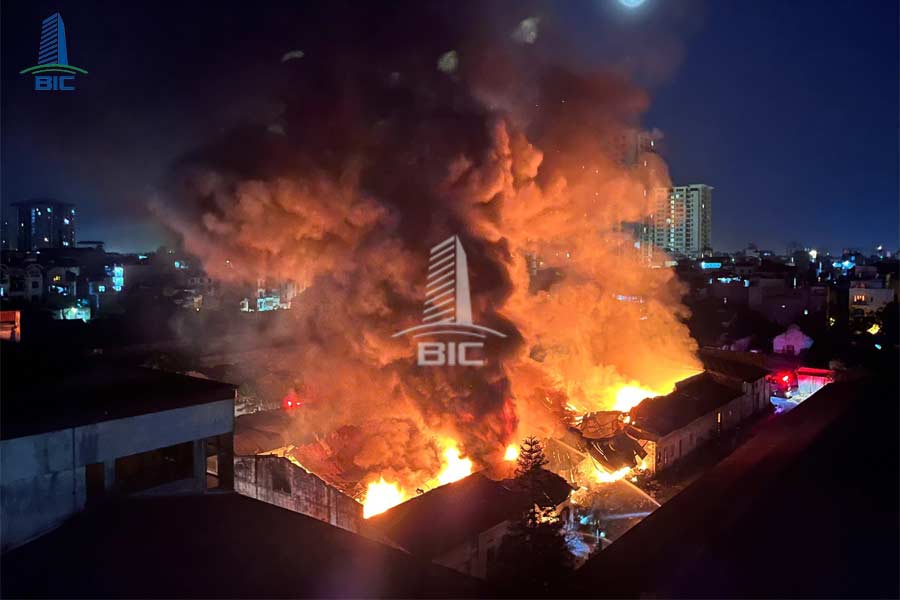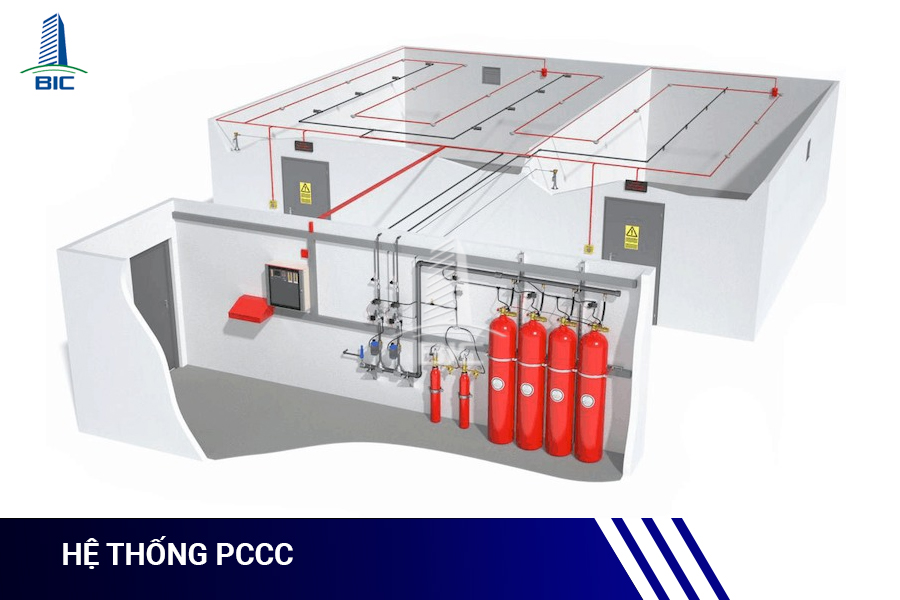
In industrial production, the risk of factory fires and explosions is always present and can occur at any time if businesses are negligent in management or construction design. Overloaded electrical systems, flammable materials, or unsafe layouts can all become causes of serious incidents, leading to significant losses of both lives and property. Many businesses have faced months-long production stoppages simply because of a small fire that spread uncontrollably due to substandard factory design.
To minimize these risks, early identification of fire and explosion hazards must be regarded as a crucial step in factory design and construction. A well-structured design that complies with fire safety standards not only reduces risks but also lays the foundation for stable and sustainable production. When businesses seriously invest in construction design, they are also investing in the long-term safety of their production systems and workforce.
Therefore, understanding potential fire and explosion risks in factories and incorporating preventive solutions right from the design stage is essential for protecting assets, maintaining production efficiency, and safeguarding corporate reputation. In this article, BIC will highlight common fire and explosion risks in factories to help you plan effective prevention measures.
Factory fire and explosion risks are not merely unexpected incidents but direct threats to a company’s survival. A single fire can destroy all assets, damage modern production lines, and cause losses worth tens of billions of dong. More seriously, loss of human life leads to long-term consequences that are difficult to overcome. This is why industrial construction experts always emphasize fire safety in every design.
When a fire occurs, production schedules are interrupted, orders are delayed, customer trust is lost, and partners may withdraw. Many companies have invested millions of dollars in equipment but lost everything within hours of a fire, forcing them to suspend operations or exit the market. This shows that neglecting fire-safe design not only increases accident risks but also directly impacts competitiveness and brand reputation.
Another factor that makes fire and explosion risks so concerning is their rapid spread in industrial environments. Factories often store large quantities of flammable materials, combined with high-capacity electrical systems and enclosed spaces, enabling fires to escalate into disasters within minutes. Without proper planning and compliance with fire safety regulations from the beginning, businesses may face devastating consequences.

Electricity is indispensable for all production activities but is also the leading cause of factory fires and explosions. The use of poor-quality wiring, incorrectly designed systems, or unscientific layouts can cause overheating and short circuits.
In many cases, companies expand production but fail to upgrade electrical systems, increasing fire risks. Incorporating electrical safety standards from the design stage is a key solution to mitigate this issue.
Factories often contain large volumes of raw materials, chemicals, packaging, or finished goods that are highly flammable. When stored in poorly ventilated spaces or without proper isolation, even a small spark can trigger a fire.
This risk is particularly high in industries such as textiles, wood, chemicals, and plastics. Therefore, designing safe warehouses, storage zones, and equipping fire safety systems is mandatory to reduce risks.

Some companies focus only on production functions and cost optimization, neglecting fire safety systems in the design stage. Factories without proper emergency exits, fire extinguishers, smoke detectors, or sprinkler systems face uncontrollable disasters in the event of a fire. Construction experts recommend treating fire protection as a core element alongside structure and functionality.
Even when a factory is designed and built to standards, fire and explosion risks still exist if businesses lack proper operation and maintenance. Uncleaned machines, unchecked production lines, and neglected fire protection equipment all reduce safety effectiveness. Regular maintenance and employee training should be considered an essential extension of safe factory design.
Fires and explosions in industrial production are not only technical incidents but also create serious, long-term impacts on businesses. Regardless of whether the cause is electrical faults, flammable materials, or poor design, the consequences often exceed recovery capabilities.
The most direct and devastating impact is human casualties and asset destruction. Hundreds of billions of dong invested in machinery, equipment, and materials can turn to ashes within hours. More gravely, injuries or fatalities among workers create workforce crises, legal liabilities, and irreparable emotional damage.
A factory fire forces production lines to halt, orders to be delayed or canceled. This not only causes direct economic losses but also affects cash flow, contract fulfillment, and future business expansion. Some companies take months or even years to recover operations after a fire.

Brand reputation is a crucial intangible asset. When fires occur, both customers and partners may lose confidence in a company’s risk management capabilities. This loss of trust can lead to partner withdrawals, customer shifts to competitors, and significant market share decline.
For these reasons, investing in fire-safe design and compliance with fire protection regulations is the key to safeguarding assets, ensuring stable operations, and maintaining market trust.
To effectively minimize risks, businesses must adopt preventive measures right from the design and construction stages and continue throughout operations. A comprehensive strategy ensures both safety and long-term production efficiency.
All factory design projects must comply with fire protection codes and standards issued by the government. This is the legal foundation for project approval and worker safety. Partnering with professional design firms ensures that structural, electrical, evacuation, and fire safety requirements are integrated from the outset, avoiding costly revisions later.
Choosing the right materials plays a decisive role in fire prevention. Heat-resistant, fireproof, and durable materials reduce fire risks and slow down fire spread. Factory structures should also be designed with ventilation, fireproof partitions, and emergency exits to ensure worker safety. This is often overlooked when businesses focus only on cost.

A modern fire protection system including smoke detectors, heat sensors, automatic sprinklers, and strategically placed extinguishers enables timely detection and response. However, installation alone is not enough. Businesses must conduct regular maintenance to ensure system reliability. Professional designers often integrate comprehensive fire safety solutions directly into factory layouts to maximize protection.
Human factors are critical in fire prevention. Workers, technicians, and managers should be trained regularly in fire response skills, extinguisher use, safe evacuation, and coordination with fire departments. With well-trained staff, factory fire risks are far better controlled.
To build factories that balance production functionality with fire safety, choosing a reputable design and construction partner is crucial. They are not just providers of drawings or construction services but also long-term partners helping businesses control fire risks from the start.
Experienced firms know how to integrate evacuation routes, storage zones, electrical systems, and fire protection equipment into design drawings. This reduces costly later adjustments while ensuring full compliance with laws and standards.
Reputable firms often adopt modern technologies and global standards to enhance safety. Using fire simulation software, designing collapse-resistant structures, or selecting advanced fireproof materials showcases professional capabilities and boosts brand value especially for foreign partnerships with strict safety demands.

Inexperienced contractors may expose businesses to massive unforeseen costs due to unsafe designs. In contrast, professional firms balance investment costs with long-term benefits. By optimizing layouts, choosing appropriate structures, and installing suitable fire systems, they help businesses save budgets while ensuring sustainable safety.
Conclusion Factory fire and explosion risks are not just technical issues but major challenges to business sustainability. A single incident can wipe out assets, disrupt production, and erode trust from customers and partners.
Proactively identifying risks, applying preventive measures, and choosing a reputable design and construction partner form the foundation for safety, operational stability, and brand protection.
Businesses that invest correctly from the design stage minimize risks while creating safe, stable, and professional production environments. This is not only a responsibility toward workers but also a smart strategy to enhance competitiveness and ensure long-term growth.